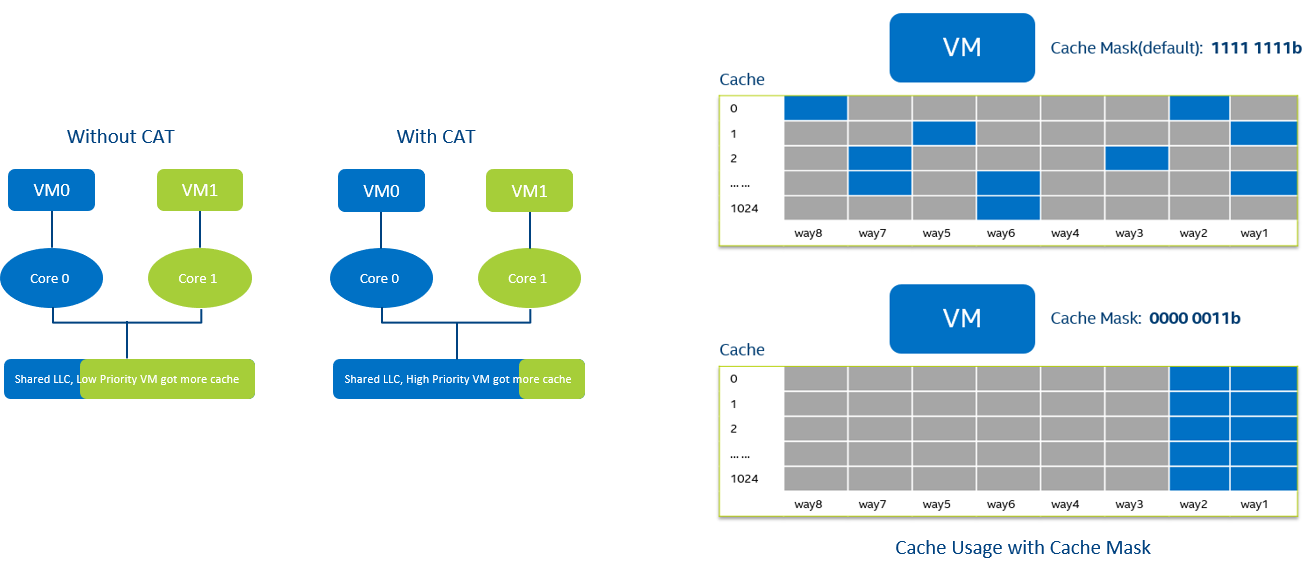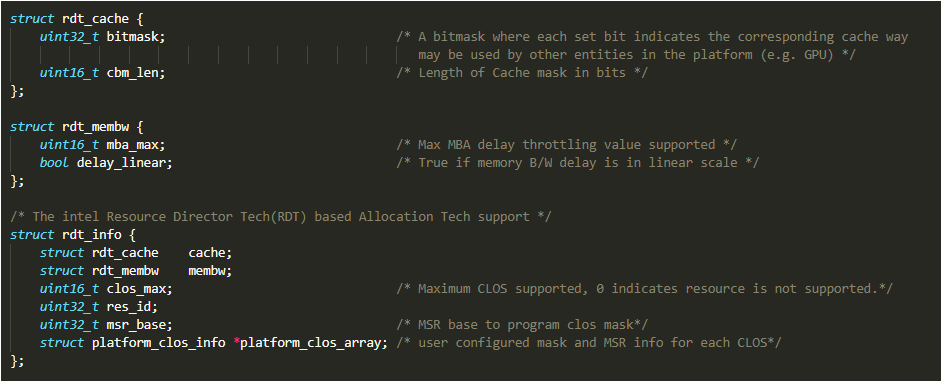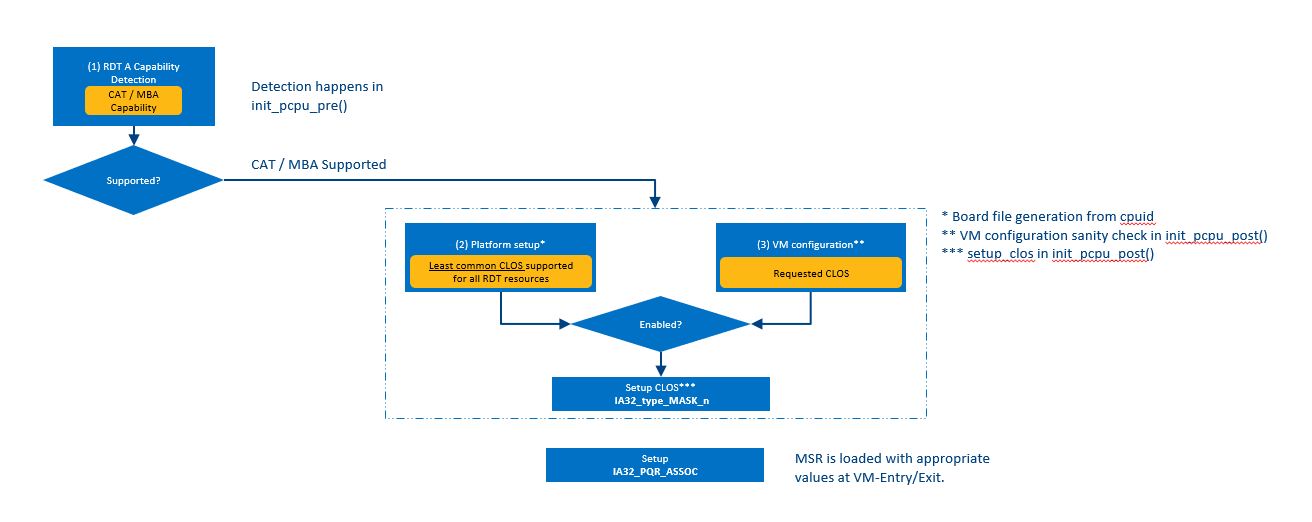RDT Allocation Feature Supported by Hypervisor¶
The ACRN hypervisor uses RDT (Resource Director Technology) allocation features such as CAT (Cache Allocation Technology) and MBA (Memory Bandwidth Allocation) to control VMs which may be over-utilizing cache resources or memory bandwidth relative to their priorities. By setting limits to critical resources, ACRN can optimize RTVM performance over regular VMs. In ACRN, the CAT and MBA are configured via the “VM-Configuration”. The resources allocated for VMs are determined in the VM configuration (Configure RDT for VM using VM Configuration).
For further details on the Intel RDT, refer to Intel 64 and IA-32 Architectures Software Developer’s Manual, (Section 17.19 Intel Resource Director Technology Allocation Features).
Objective of CAT¶
The CAT feature in the hypervisor can isolate the cache for a VM from other VMs. It can also isolate cache usage between VMX root and non-root modes. Generally, certain cache resources are allocated for the RT VMs in order to reduce performance interference through the shared cache access from the neighbor VMs.
The figure below shows that with CAT, the cache ways can be isolated vs the default where high priority VMs can be impacted by a noisy neighbor.
CAT Support in ACRN¶
On x86 platforms that support CAT, the ACRN hypervisor automatically enables support and by default shares the cache ways equally between all VMs. This is done by setting the max cache mask in the MSR_IA32_type_MASK_n (where type: L2 or L3) MSR that corresponds to each CLOS and then setting the IA32_PQR_ASSOC MSR to CLOS 0. (Note that CLOS, or Class of Service, is a resource allocator.) The user can check the cache capabilities such as cache mask and max supported CLOS as described in RDT detection and resource capabilites and then program the IA32_type_MASK_n and IA32_PQR_ASSOC MSR with a CLOS ID, to select a cache mask to take effect. ACRN uses VMCS MSR loads on every VM Entry/VM Exit for non-root and root modes to enforce the settings.
struct platform_clos_info platform_l2_clos_array[MAX_PLATFORM_CLOS_NUM] = { { .clos_mask = 0xff, .msr_index = MSR_IA32_L3_MASK_BASE + 0, }, { .clos_mask = 0xff, .msr_index = MSR_IA32_L3_MASK_BASE + 1, }, { .clos_mask = 0xff, .msr_index = MSR_IA32_L3_MASK_BASE + 2, }, { .clos_mask = 0xff, .msr_index = MSR_IA32_L3_MASK_BASE + 3, }, };struct acrn_vm_config vm_configs[CONFIG_MAX_VM_NUM] __aligned(PAGE_SIZE) = { { .type = SOS_VM, .name = SOS_VM_CONFIG_NAME, .guest_flags = 0UL, .clos = 0, .memory = { .start_hpa = 0x0UL, .size = CONFIG_SOS_RAM_SIZE, }, .os_config = { .name = SOS_VM_CONFIG_OS_NAME, }, }, };
Note
ACRN takes the lowest common CLOS max value between the supported resources and sets the MAX_PLATFORM_CLOS_NUM. For example, if max CLOS supported by L3 is 16 and L2 is 8, ACRN programs MAX_PLATFORM_CLOS_NUM to 8. ACRN recommends consistent capabilities across all RDT resources by using the common subset CLOS. This is done in order to minimize misconfiguration errors.
Objective of MBA¶
The Memory Bandwidth Allocation (MBA) feature provides indirect and approximate control over memory bandwidth that’s available per core. It provides a method to control VMs which may be over-utilizing bandwidth relative to their priorities and thus improves the performance of high priority VMs. MBA introduces a programmable request rate controller (PRRC) between cores and high-speed interconnect. Throttling values can be programmed via MSRs to the PRRC to limit bandwidth availability.
The following figure shows memory bandwidth impact without MBA which causes bottlenecks for high priority VMs vs with MBA support:
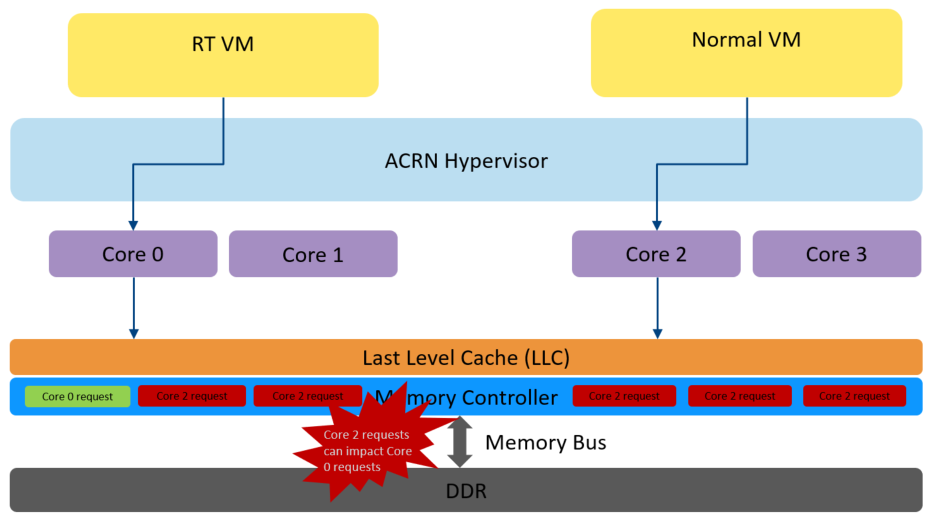
Figure 197 Without MBA Support
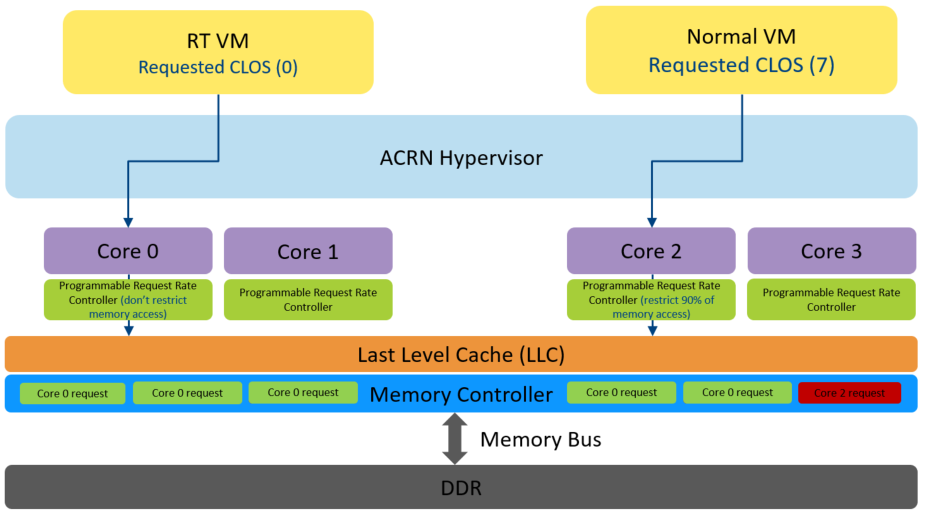
Figure 198 With MBA Support
MBA Support in ACRN¶
On x86 platforms that support MBA, the ACRN hypervisor automatically enables support and by default sets no limits to the memory bandwidth access by VMs. This is done by setting a 0 mba delay value in the MSR_IA32_MBA_MASK_n MSR that corresponds to each CLOS and then setting IA32_PQR_ASSOC MSR with CLOS 0. To select a delay to take effect for restricting memory bandwidth, users can check the MBA capabilities such as mba delay values and max supported CLOS as described in RDT detection and resource capabilites and then program the IA32_MBA_MASK_n and IA32_PQR_ASSOC MSR with the CLOS ID. ACRN uses VMCS MSR loads on every VM Entry/VM Exit for non-root and root modes to enforce the settings.
struct platform_clos_info platform_mba_clos_array[MAX_PLATFORM_CLOS_NUM] = { { .mba_delay = 0, .msr_index = MSR_IA32_MBA_MASK_BASE + 0, }, { .mba_delay = 0, .msr_index = MSR_IA32_MBA_MASK_BASE + 1, }, { .mba_delay = 0, .msr_index = MSR_IA32_MBA_MASK_BASE + 2, }, { .mba_delay = 0, .msr_index = MSR_IA32_MBA_MASK_BASE + 3, }, };struct acrn_vm_config vm_configs[CONFIG_MAX_VM_NUM] __aligned(PAGE_SIZE) = { { .type = SOS_VM, .name = SOS_VM_CONFIG_NAME, .guest_flags = 0UL, .clos = 0, .memory = { .start_hpa = 0x0UL, .size = CONFIG_SOS_RAM_SIZE, }, .os_config = { .name = SOS_VM_CONFIG_OS_NAME, }, }, };
Note
ACRN takes the lowest common CLOS max value between the supported resources and sets the MAX_PLATFORM_CLOS_NUM. For example, if max CLOS supported by L3 is 16 and MBA is 8, ACRN programs MAX_PLATFORM_CLOS_NUM to 8. ACRN recommends to have consistent capabilities across all RDT resources by using a common subset CLOS. This is done in order to minimize misconfiguration errors.
CAT and MBA high-level design in ACRN¶
Enabling CAT, MBA software flow¶
The hypervisor enumerates RDT capabilities and sets up mask arrays; it also sets up CLOS for VMs and the hypervisor itself per the “vm configuration”(Configure RDT for VM using VM Configuration).
- The RDT capabilities are enumerated on the bootstrap processor (BSP) during
the pCPU pre-initialize stage. The global data structure
res_cap_infostores the capabilites of the supported resources. - If CAT or/and MBA is supported, then setup masks array on all APs at the pCPU post-initialize stage. The mask values are written to IA32_type_MASK_n. Refer to RDT detection and resource capabilites for details on identifying values to program the mask/delay MRSs and the max CLOS.
- If CAT or/and MBA is supported, the CLOS of a VM will be stored into
its vCPU
msr_store_areadata structure guest part. It will be loaded to MSR IA32_PQR_ASSOC at each VM entry. - If CAT or/and MBA is supported, the CLOS of hypervisor is stored for
all VMs, in their vCPU
msr_store_areadata structure host part. It will be loaded to MSR IA32_PQR_ASSOC at each VM exit.
The figure below shows the high level overview of RDT resource flow in the ACRN hypervisor.
